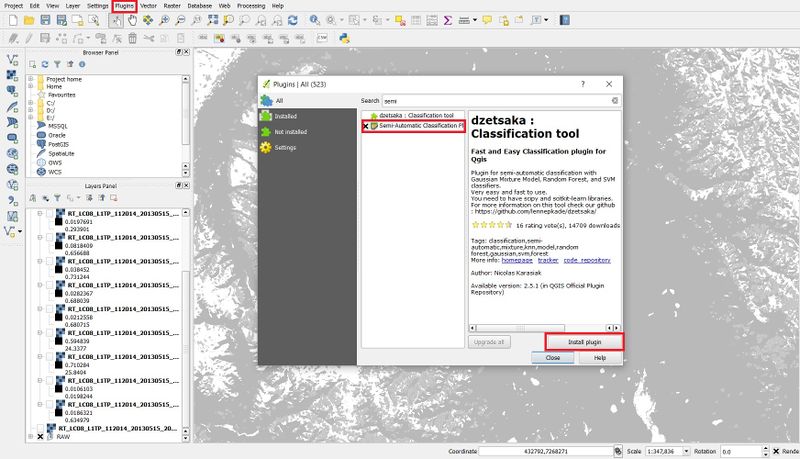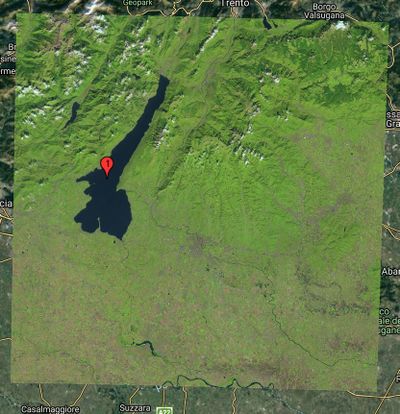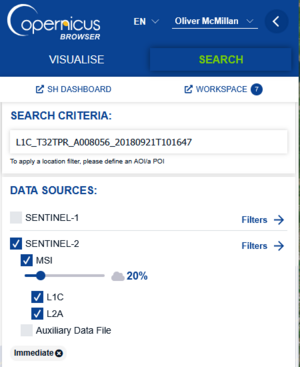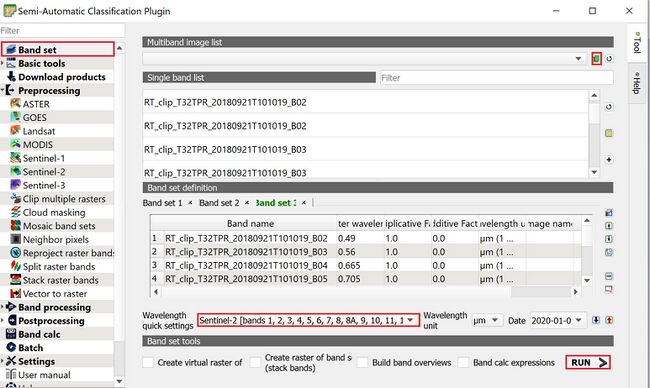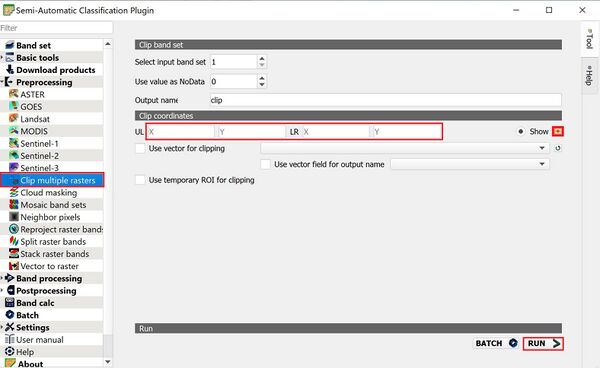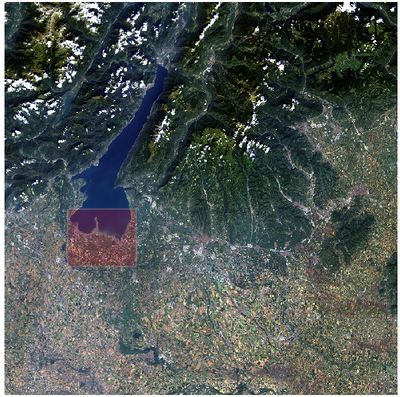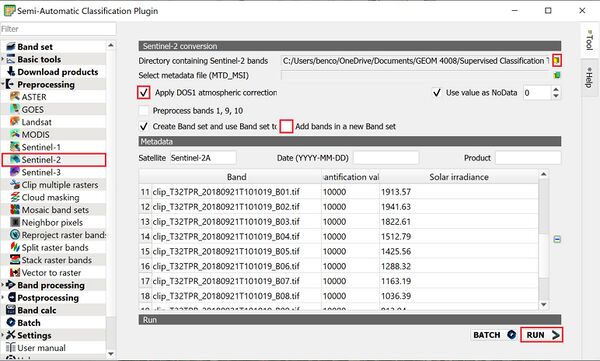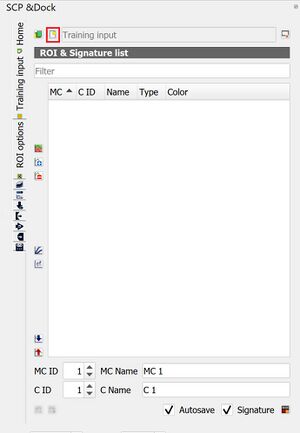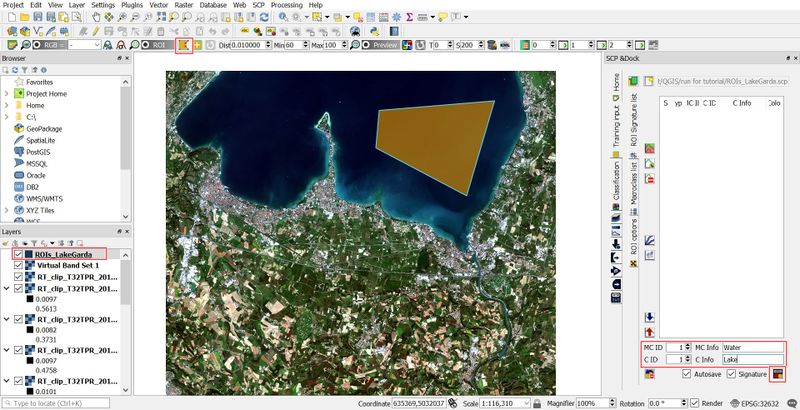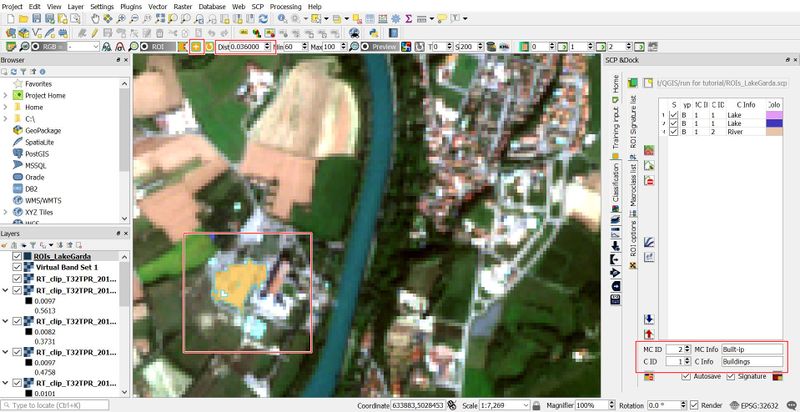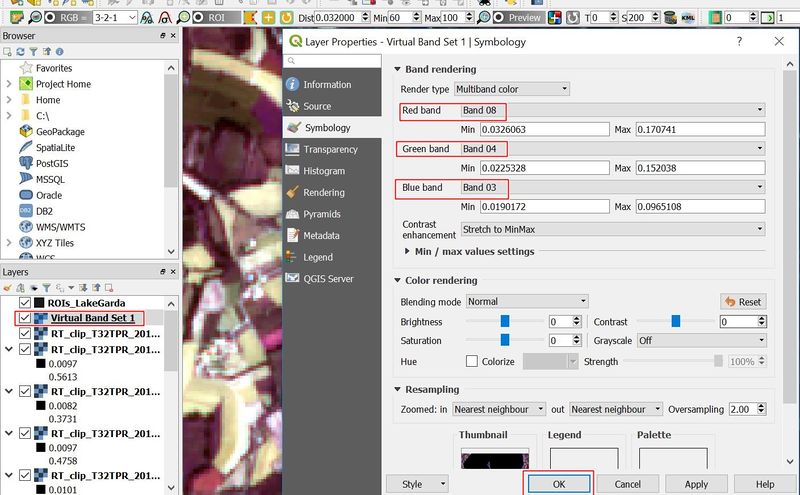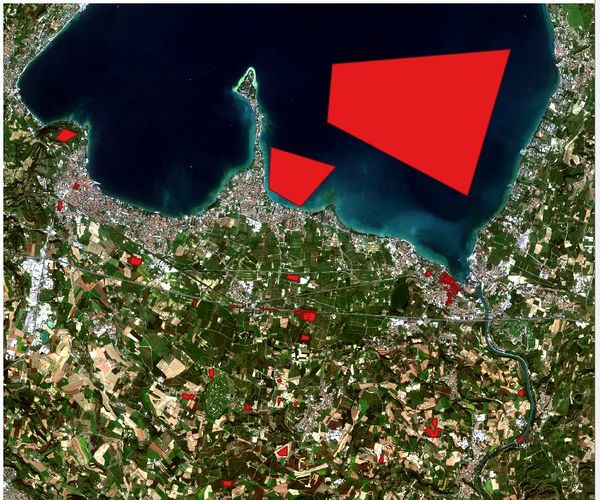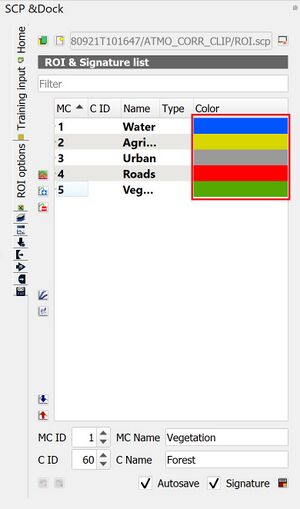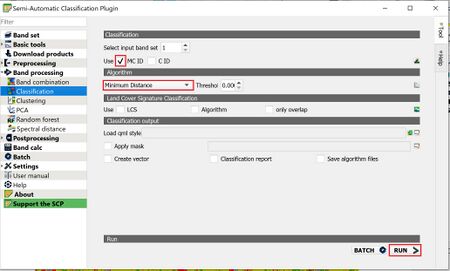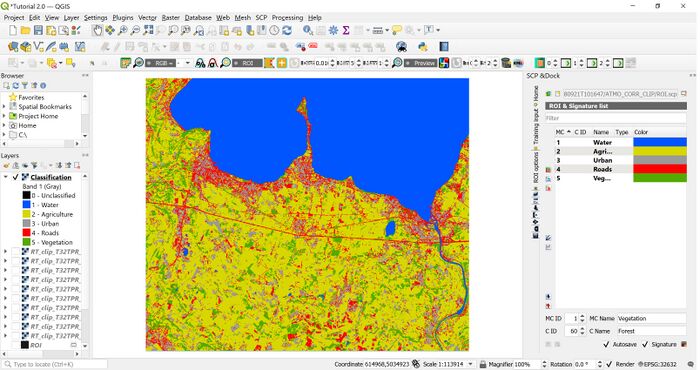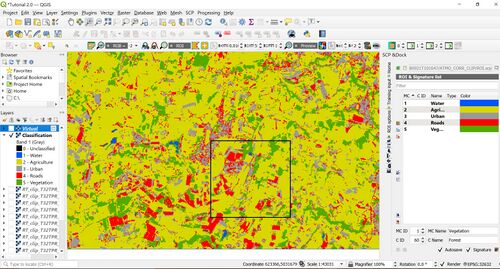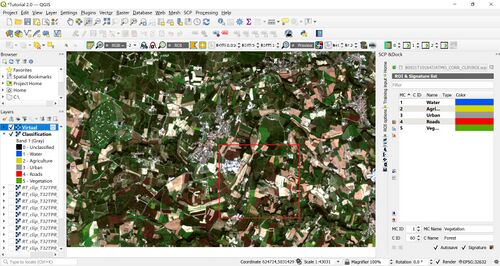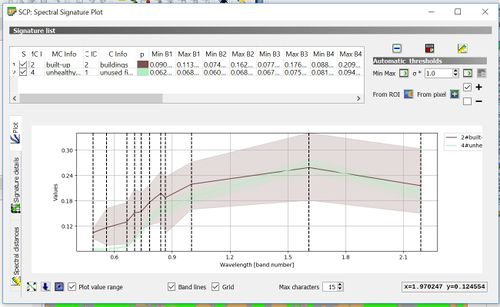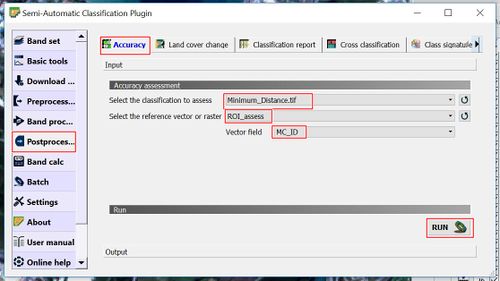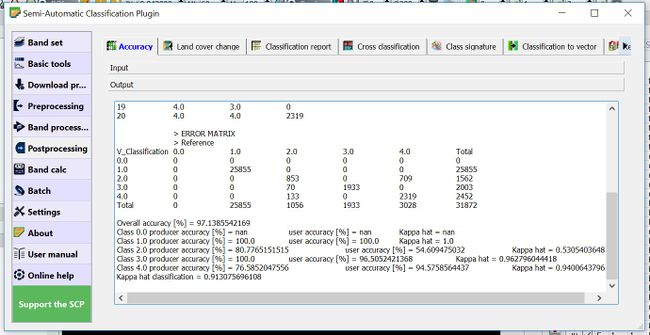Difference between revisions of "Supervised classification in QGIS"
| (134 intermediate revisions by 3 users not shown) | |||
| Line 1: | Line 1: | ||
| − | ==Purpose== |
+ | ==Purpose and Introduction== |
| − | Every day thousands of satellite images are taken. To work with these images they need to be processed, e.g. they need to be classified. Since Remote Sensing software can be very expensive this tutorial |
+ | Every day thousands of satellite images are taken. To work with these images they need to be processed, e.g. they need to be classified. Since Remote Sensing software can be very expensive this tutorial will provide an open-source alternative: the Semi-automatic-classification plugin (SCP) in QGIS. The tutorial is going through a basic supervised land-cover classification with Sentinel-2 data. It is one suggestion to use the SCP. After running through the following workflow you will know the SCP better and you will be able to discover more opportunities to work with remote-sensing Data in QGIS. You can also find another tutorial about the SCP here [https://gracilis.carleton.ca/CUOSGwiki/index.php/Remote_Sensing_Analysis_in_QGIS]. Feel free to combine both tutorials. |
| + | Land cover classification allocates every pixel in a raster image to a defined class depending on the spectral signature curve. The classification will provide quantitative information about the land-use. |
||
| − | ==Introduction== |
||
| − | Land-cover classification classifies every pixel to a defined class using the spectral signatures. To define the classes region of interests (ROI) must be set. |
||
==Installing the Software and SCP== |
==Installing the Software and SCP== |
||
| − | To start the tutorial you have to download the latest version of QGIS which is QGIS 3.4.1. "Bonn" and can be found here[https://qgis.org/en/site/forusers/download.html]. Make sure to download the proper version for your PC (34bit vs. 64bit). After installing the software |
+ | To start the tutorial you have to download the latest version of QGIS which is QGIS 3.4.1. "Bonn" and can be found here[https://qgis.org/en/site/forusers/download.html]. Make sure to download the proper version for your PC (34bit vs. 64bit). After installing the software the Semi-automatic classification Plugin (SCP) must be installed into QGIS. Navigate to the menu at the top to ''Plugin'' and select ''Manage and Install Plugins''. Following the picture, the SCP can be found while typing "semi" in the search bar. Click ''install plugin'' and now you should be able to see the SCP Dock at the right or left side of your user surface. |
| + | |||
[[File:SCP.jpg|800px]] |
[[File:SCP.jpg|800px]] |
||
==Obtaining the Data== |
==Obtaining the Data== |
||
| − | In this Tutorial, Sentinel-2 Data from the south of Lake Garda, Italy is used to run the classification. The data can be downloaded from the USGS Earth Explorer website here[https://earthexplorer.usgs.gov/]. You can |
+ | In this Tutorial, Sentinel-2 Data from the south of Lake Garda, Italy is used to run the classification. The data can be downloaded from the USGS Earth Explorer website here[https://earthexplorer.usgs.gov/]. You can find an explanation of how to download data from the Earth Explorer in the tutorial [[Remote Sensing Analysis in QGIS]]. To find the same picture used in this tutorial: select world features, search for Lake Garda and select the time period from August to October 2018. Among Data Sets, select Sentinel-2 then under additional criteria paste the entity ID: '''L1C_T32TPR_A008056_20180921T101647''' Date: 21st of September 2018. You should find the following picture: |
[[File:Sentinel-2image.JPG|400px]] |
[[File:Sentinel-2image.JPG|400px]] |
||
| − | ID: '''L1C_T32TPR_A008056_20180921T101647''' Date: 21st of September 2018. |
+ | Entity ID: '''L1C_T32TPR_A008056_20180921T101647''' Date: 21st of September 2018. |
| + | |||
| + | It is always easier to work with cloud-free pictures, otherwise, you have to use a cloud mask. |
||
| + | |||
| + | |||
| + | '''Copernicus Browser''' is another option, it is the European Space Agency's equivalent to USGS earth explorer but focuses on Sentinel data. Go to [https://browser.dataspace.copernicus.eu/?zoom=5&lat=50.16282&lng=20.78613&themeId=DEFAULT-THEME&visualizationUrl=U2FsdGVkX188tgNdFi%2FL3tpFa0q6CLBfOt2NICr3ZIWELzc2vM9jWiPOR2XjZFetLoOWjtVb7GQWUj9DGUK2Ek1wE%2BpqvwMHQ7p1eaFithPVU1D2o5lP73lP%2BSRcZwDY&datasetId=S2_L2A_CDAS&demSource3D=%22MAPZEN%22&cloudCoverage=30&dateMode=SINGLE Copernicusbrowser.com] and create an account if you don't already have one. |
||
| + | |||
| + | For a tutorial on how to use the browser and get the imagery you're interested in click the little "i" at the top right of the page. |
||
| + | |||
| + | [[File:Copernicus Browser information icon.png|500px|Click the little 'i' in the top right of the browser.]] |
||
| + | |||
| + | |||
| + | Images can be found by filtering by date, aoi, and product type. You can search for the same image used above by copying and pasting the image id into the search bar. |
||
| + | |||
| + | [[File:Copernicus Browser Search.png|300px|]] |
||
===Unpack the Data=== |
===Unpack the Data=== |
||
| − | + | Download the data under 'Download Options' and select the JPEG version. The image is packed in a zip-File, therefore, you have to unzip the Data before working with it. Afterwards, you can find the image data in your home directory under '''GRANULE''' → '''L1C_T32TPR_A008056_20180921T101647''' → '''IMG_DATA'''. For each band of the satellite data there is a separate JPEG file. |
|
| + | Note: Make sure to save your data in a folder that you are comfortable with. There may be added difficulty if the unzipped file is kept in your download folder or on your desktop. Additionally, a way to make the bands more recognizable and easy to manage is to rename them in their file directory to their corresponding band names. For example, '''RT_clip_T32TPR_20180921T101019_B03''' will be renamed to '''Band 3 - Green (10 m)'''. Here's a reference to all 12 Sentinel-2 bands[https://www.satimagingcorp.com/satellite-sensors/other-satellite-sensors/sentinel-2a/] |
||
| − | ==Preprocessing the Data== |
||
| − | Before starting the classification some some steps must be done before. |
||
| − | ===Load the Data into QGIS=== |
||
| − | To load the Data into QGIS navigate to '''Layer''' at the top your user surface. Choose '''Add Layer''', and then '''Add Raster Layer...'''. You should see the Data Source Manager now. Leave "File" selected like it is in default. Under Datasets you can navigate to the directory described above where you find the imageries. Make sure to load all JPEG files into QGIS '''except the file of band 10''': T32TPR_20180921T101019_B10. |
||
| − | Band 10 is the Cirrus band and not useful for this approach. |
||
| + | Note: Occasionally QGIS gets confused if you rename the bands so it is best to keep them as they were. |
||
| − | ===Creating an Band set=== |
||
| − | The next step is to create a band set. Navigate to the '''SCP''' button at the top of the user surface and select '''Band set'''. Under '''Multiband image list''' you can load the images into SCP and then into the Band Set 1. Make sure the layers are in the right order and select Sentinel-2 under '''Quick wavelength units'''. The picture below should help to understand these steps. |
||
| + | ==Load the Data into QGIS and Preprocess it== |
||
| − | [[File:CreateBandSet.JPG|700px]] |
||
| + | To load the data into QGIS navigate to '''Layer''' at the top your user surface. Choose '''Add Layer''', and then '''Add Raster Layer...'''. You should see the '''Data Source Manager''' now. Leave "File" selected like it is in default. Under '''Datasets''' you can navigate to the directory described above where you find the imageries. Make sure to load all JPEG files into QGIS '''except the file of band 10''': T32TPR_20180921T101019_B10. |
||
| + | Band 10 is the Cirrus band and is not needed for this approach. |
||
| + | ===Creating a Band set=== |
||
| − | If you do not want to see a gray scaled image navigate to the top of your surface to '''RGB''' and choose '''3-2-1''' to see true colours. |
||
| + | The next step is to create a band set. Navigate to the '''SCP''' button at the top of the user surface and select '''Band set'''. Under '''Multiband image list''' you can load the images into SCP and then into the Band Set 1. Select Sentinel-2 under '''Quick wavelength units'''. As you can see, the layers are seen under Band Set 1 (e.g. Band 2 - Blue (10 m). Make sure the bands are in the right order and ascending. The picture below should help to understand these steps. |
||
| + | |||
| − | [[File:RGB.JPG|100px]] |
||
| + | [[File:CreateBandSet..jpg|650px]] |
||
| + | |||
| + | |||
| + | If you do not want to see a grayscaled image navigate to the SCP toolbar at the top of your surface to '''RGB''' and choose '''4-3-2''' to see a composite image. Additionally you can also create a virtual raster layer by selecting at the top of your toolbar '''Raster''' → '''Miscellaneous''' → '''Build Virtual Raster...'''. Once the tool is open select bands 2, 3, and 4 under '''Input layers''' click '''OK''' and select the '''Place each input file into a separate band''' box then click '''Run'''. Next, double click on the '''Virtual''' layer you just created to open up the '''Symbology''' tab and for the Red, Green, and Blue bands select bands 3, 2, 1 respectfully. |
||
| + | |||
| + | Note: bands 2, 3, and 4, (blue, green, and red) change to bands 1, 2, and 3 in the virtual raster layer. |
||
| + | |||
| + | |||
| + | [[File:4-3-2.JPG|125px]] |
||
| + | |||
| + | Note: You should deselect all the layers besides the virtual layer you created to speed up the various processes that will be done in the next steps. |
||
===Clip the Data=== |
===Clip the Data=== |
||
| − | + | Since the area of the picture is very large it is reasonable to work with just a section of the image. Therefore, the SCP allows us to clip the data and only work with a part of the picture. Navigate to the '''SCP''' button at the top of the user surface, under '''Preprocessing''' you find '''clip multiple Raster'''. Your surface should look similar like in the picture below. Choose '''Band set 1''' which you defined in the previous step. |
|
| − | [[File: |
+ | [[File:RasterClip.jpg|600px]] |
| − | To clip the data press the orange button with the plus. Minimize the SCP window and you can now define the area you want to work with while clicking with the right button on your mouse. I suggest |
+ | To clip the data press the orange button with the plus. Minimize the SCP window and you can now define the area you want to work with while clicking with the right button on your mouse or by manually entering the UL (upper left) and LR (lower right) coordinates of the desired clip area. I suggest defining an area south of the mountains to avoid dealing with mountain shadows in the classification. In addition, in the south of the picture, the scenery is cloud-free. For instance, choose an area like this: |
| Line 48: | Line 71: | ||
| − | After defining the section under |
+ | After defining the section, under '''Clip coordinates''' there should be coordinates for the area you just defined. Click run and define an output folder. In the '''Layer Dock''', for each Band (1-9,11,12) a separate resized Raster Layer occurs. Once your clip layers have been created, you may remove the original band layers to free up some space in your layers legend. |
===Automatic Conversion to Surface Reflection=== |
===Automatic Conversion to Surface Reflection=== |
||
| − | + | The last preprocessing step is to run an atmospheric correction. Go to '''SCP, Preprocessing, Sentinel-2''' and choose the directory where you saved the clipped data. Check '''Apply DOS1 atmospheric correction''' and uncheck '''Add bands in a new bandset''' as you will only need to update the current bands you have, and not create new ones. The solar radiance should be recognized automatically. Click run and define an output folder. |
|
| − | [[File: |
+ | [[File:S2conversion.jpg|600px]] |
The output files will be named e.g. like this: '''RT_clip_T32TPR_20180921T101019_B03'''. |
The output files will be named e.g. like this: '''RT_clip_T32TPR_20180921T101019_B03'''. |
||
| − | |||
== Supervised Classification == |
== Supervised Classification == |
||
| − | We can now begin with the supervised classification. Make sure you see the SCP&Dock at your surface. |
+ | We can now begin with the supervised classification. Make sure you see the '''SCP & Dock''' at your surface. If not, clicking this button [[File:OpenSCP.JPG]] in the toolbar will open it. |
| − | ===Set Region of |
+ | ===Set Region of Interest (ROI)=== |
| − | First |
+ | First, you must create a file where the ROIs can be saved. To do so, click '''Training input''' then this button: |
| − | [[File: |
+ | [[File:Roi.jpg|300px]] |
| + | |||
| − | Click the Create a ROI button to create the first ROI. You can define the ROI with mouse clicks, to complete it click right. |
||
| + | Click the '''Create a ROI''' button to create the first ROI. You can define the ROI with mouse clicks, to complete it, click right. |
||
[[File:Create_ROI.JPG]] |
[[File:Create_ROI.JPG]] |
||
| + | Note: '''Save''' often when creating ROI's. This is a time consuming process and if the program were to crash you could loose many minutes of your time. |
||
| − | In the following picture the first ROI is in the lake. You can see that the macro class ('''MC ID''') is named Water and the subclass ('''C ID''') Lake. In this tutorial only the macro |
+ | In the following picture, the first ROI is in the lake. You can see that the macro class ('''MC ID''') is named ''Water'' and the subclass ('''C ID''') ''Lake''. Make sure to change the '''MC ID''' name when creating ROI's for different land classes. In this tutorial, only the macro classes will be significant, since it is a basic classification with only five different classes. If you want to have more specific classes you can use the subclasses. Save the ROI. |
| Line 83: | Line 107: | ||
| − | A second option to create |
+ | A second option to create a ROI is to activate a '''ROI pointer'''. This can be done while clicking the plus in the red box (see the following picture) and defining the radius where the SCP should look for similar pixels. The ROI pointer is fast and works well but you have to be cautious not to include too many unnecessary features. Your ROI could look like this: |
| Line 89: | Line 113: | ||
| + | In this tutorial, 5 macro classes will be defined: water, agriculture, vegetation, urban, and roads. Since vegetation is reflecting light in NIR (Near infrared), we can visualize it in an image with false colours and therefore distinguish between healthy and unhealthy vegetation. To do so, click right on the layer '''Virtual Band Set 1''' and choose '''Properties'''. Define Band 08 (NIR) as red, Band 04 (Red) as green and Band 3 (green) as blue like in the image below. |
||
| − | In this tutorial 4 macro classes will be defined: water, built-up area, healthy vegetation, unhealthy vegetation. |
||
| + | |||
| + | |||
| + | [[File:Editfalsecolours.JPG|800px]] |
||
| + | |||
| + | |||
| + | If you look closely at the screenshot below, many of the agricultural fields (bottom centre) have a similar reflectance to the roads and urban environment (turquoise/grey). It is important to create an adequate amount of ROI's for each class to ensure accurate classification. |
||
| + | |||
| + | |||
| + | [[File:falsecolours.JPG|600px]] |
||
| + | |||
| + | |||
| + | Keep going setting ROIs for the five classes, you should set at least 10 ROIs per class. Try to be as accurate as possible, to make sure that pixels are assigned to the proper class. In the following picture an example of several ROIs is shown: |
||
| + | |||
| + | |||
| + | [[File:ROIs.JPG|600px]] |
||
| + | |||
| + | |||
| + | Before we run the classification we can change the colours of the macro classes in the SCP Dock. You can collapse the classes by double-clicking on their names then by double-clicking on the colour fields to change their colours. |
||
| + | |||
| + | [[File:Macro.jpg|300px]] |
||
| + | |||
| + | |||
| + | Choose an appropriate colour for every class. |
||
| + | |||
| + | ===Running the classification=== |
||
| + | |||
| + | Now go to the '''Classification''' tab in the SCP window under '''Band processing'''. You will notice that there are various options to run the classification. For instance, there are different classification algorithms: Minimum Distance, Maximum Likelihood or Spectral Angle Mapper. Feel free to try all three of them. It always depends on the approach and the data which algorithm works the best. If you check LCS, the Landcover Signature classification algorithm will be used. If you uncheck it, the chosen algorithm above will be used. In the classification of this tutorial, the Minimum Distance Algorithm and Spectral Angle Mapping came out as the best classification algorithms. |
||
| + | |||
| + | |||
| + | [[File:Classy.jpg|450px]] |
||
| + | |||
| + | |||
| + | Check '''MC ID''' to use the macro classes and uncheck '''LCS'''. Click run and safe the classification in your desired directory. If areas occur unclassified go back and set more ROIs. |
||
| + | |||
| + | |||
| + | The output can look like this: |
||
| + | |||
| + | |||
| + | [[File:Classy2.jpg|700px]] |
||
| + | |||
| + | ==Assessing the classification== |
||
| + | |||
| + | You can assess the classification while comparing the true colour image with the classification layer. You can move the classification Layer above the Virtual band Set 1. Zoom into the picture and focus on an object. Checking and unchecking the classification layer allows you to verify the classes. As you see, it is difficult for the program to distinguish between unused fields and buildings/roads. |
||
| + | |||
| + | |||
| + | [[File:Classyclose.jpg|500px]] [[File:Virtual2.jpg|500px]] |
||
| + | |||
| + | |||
| + | The following picture explains why the two classes are mixed up sometimes. |
||
| + | |||
| + | |||
| + | [[File:Signature2.JPG|500px]] |
||
| + | |||
| + | |||
| + | Built-up area (brown line) and unhealthy vegetation (turquoise line) have very similar spectral signature plot and the algorithm uses these signatures for the calculation. However, you can reduce this error by setting more ROIs. Another possibility would be to include indices in the classification which are explained in the Tutorial mentioned above ([[Remote Sensing Analysis in QGIS]]). Unfortunately, you cannot totally overcome the error. |
||
| + | |||
| + | |||
| + | You can visualize the spectral signature for every ROI. For this select the ROIs you want to visualize and click '''Add highlighted signatures to the signature plot'''. |
||
| + | |||
| + | |||
| + | [[File:SignatureList.JPG|300px]] |
||
| + | |||
| + | |||
| + | The SCP provides a lot of options to achieve a good classification result. It depends on the approach, how much time one wants to spend to improve the classification. The SCP provides even more options to improve the ROIs while altering the spectral signatures for different classes. Nonetheless, it will not be possible to classify every single pixel right. |
||
| + | |||
| + | ===Calculate the Users and Producers Accuracy=== |
||
| + | A quantitative method to assess the classification is to calculate Users and Producers accuracy. First, you have to create a new layer with ROIs and set again ROIs for the four classes to have a reference ground. You cannot use the ROIs you used for the classification because you want to compare the classification with undependable training input. After you created various ROIs open the SCP and go to '''Postprocessing''', '''Accuracy'''. As your input layer choose your best classification result. The reference raster layer will be the new ROIs you just set: |
||
| + | |||
| + | [[File:Accuracy assessment.JPG|500px]] |
||
| + | |||
| + | |||
| + | The output will tell you the accuracy for each class and the overall accuracy. |
||
| + | |||
| + | [[File:ErrorMatrix.JPG|650px|thumb|none|Accuracy assessment Report of the Minimum Distance classification]] |
||
| + | [[File:Sepctralangle assessment.JPG|600px|thumb|none|Accuracy assessment report of the Spectral Angle Mapper classification]] |
||
| + | |||
| + | |||
| + | The output will tell you the accuracy for each class and the overall accuracy. Users accuracy is a measure of false positives or type 1 errors. Producers accuracy is a measure of false negatives or type 2 errors. For both users and producers accuracy higher percentages mean lower errors rates. They are two sides of the same coin and give us an idea of the types of inaccuracies that we have in our classification. We can determine which classes were confused for others in the error matrix. You can learn how to read the error matrix and learn more on user and producer accuracies [https://pro.arcgis.com/en/pro-app/latest/help/analysis/image-analyst/accuracy-assessment.htm here]. The overall accuracy is a combination of both measures. |
||
| + | |||
| + | ==Conclusion== |
||
| + | |||
| + | The tutorial showed one possible remote sensing workflow in QGIS and also provides an introduction into the SCP Plugin and hopefully motivated you to try out more. You can find more information about the Plugin here [https://fromgistors.blogspot.com/p/semi-automatic-classification-plugin.html] and discover more tools the SCP offers. |
||
Latest revision as of 13:06, 26 October 2025
Contents
Purpose and Introduction
Every day thousands of satellite images are taken. To work with these images they need to be processed, e.g. they need to be classified. Since Remote Sensing software can be very expensive this tutorial will provide an open-source alternative: the Semi-automatic-classification plugin (SCP) in QGIS. The tutorial is going through a basic supervised land-cover classification with Sentinel-2 data. It is one suggestion to use the SCP. After running through the following workflow you will know the SCP better and you will be able to discover more opportunities to work with remote-sensing Data in QGIS. You can also find another tutorial about the SCP here [1]. Feel free to combine both tutorials.
Land cover classification allocates every pixel in a raster image to a defined class depending on the spectral signature curve. The classification will provide quantitative information about the land-use.
Installing the Software and SCP
To start the tutorial you have to download the latest version of QGIS which is QGIS 3.4.1. "Bonn" and can be found here[2]. Make sure to download the proper version for your PC (34bit vs. 64bit). After installing the software the Semi-automatic classification Plugin (SCP) must be installed into QGIS. Navigate to the menu at the top to Plugin and select Manage and Install Plugins. Following the picture, the SCP can be found while typing "semi" in the search bar. Click install plugin and now you should be able to see the SCP Dock at the right or left side of your user surface.
Obtaining the Data
In this Tutorial, Sentinel-2 Data from the south of Lake Garda, Italy is used to run the classification. The data can be downloaded from the USGS Earth Explorer website here[3]. You can find an explanation of how to download data from the Earth Explorer in the tutorial Remote Sensing Analysis in QGIS. To find the same picture used in this tutorial: select world features, search for Lake Garda and select the time period from August to October 2018. Among Data Sets, select Sentinel-2 then under additional criteria paste the entity ID: L1C_T32TPR_A008056_20180921T101647 Date: 21st of September 2018. You should find the following picture:
Entity ID: L1C_T32TPR_A008056_20180921T101647 Date: 21st of September 2018.
It is always easier to work with cloud-free pictures, otherwise, you have to use a cloud mask.
Copernicus Browser is another option, it is the European Space Agency's equivalent to USGS earth explorer but focuses on Sentinel data. Go to Copernicusbrowser.com and create an account if you don't already have one.
For a tutorial on how to use the browser and get the imagery you're interested in click the little "i" at the top right of the page.
Images can be found by filtering by date, aoi, and product type. You can search for the same image used above by copying and pasting the image id into the search bar.
Unpack the Data
Download the data under 'Download Options' and select the JPEG version. The image is packed in a zip-File, therefore, you have to unzip the Data before working with it. Afterwards, you can find the image data in your home directory under GRANULE → L1C_T32TPR_A008056_20180921T101647 → IMG_DATA. For each band of the satellite data there is a separate JPEG file.
Note: Make sure to save your data in a folder that you are comfortable with. There may be added difficulty if the unzipped file is kept in your download folder or on your desktop. Additionally, a way to make the bands more recognizable and easy to manage is to rename them in their file directory to their corresponding band names. For example, RT_clip_T32TPR_20180921T101019_B03 will be renamed to Band 3 - Green (10 m). Here's a reference to all 12 Sentinel-2 bands[4]
Note: Occasionally QGIS gets confused if you rename the bands so it is best to keep them as they were.
Load the Data into QGIS and Preprocess it
To load the data into QGIS navigate to Layer at the top your user surface. Choose Add Layer, and then Add Raster Layer.... You should see the Data Source Manager now. Leave "File" selected like it is in default. Under Datasets you can navigate to the directory described above where you find the imageries. Make sure to load all JPEG files into QGIS except the file of band 10: T32TPR_20180921T101019_B10. Band 10 is the Cirrus band and is not needed for this approach.
Creating a Band set
The next step is to create a band set. Navigate to the SCP button at the top of the user surface and select Band set. Under Multiband image list you can load the images into SCP and then into the Band Set 1. Select Sentinel-2 under Quick wavelength units. As you can see, the layers are seen under Band Set 1 (e.g. Band 2 - Blue (10 m). Make sure the bands are in the right order and ascending. The picture below should help to understand these steps.
If you do not want to see a grayscaled image navigate to the SCP toolbar at the top of your surface to RGB and choose 4-3-2 to see a composite image. Additionally you can also create a virtual raster layer by selecting at the top of your toolbar Raster → Miscellaneous → Build Virtual Raster.... Once the tool is open select bands 2, 3, and 4 under Input layers click OK and select the Place each input file into a separate band box then click Run. Next, double click on the Virtual layer you just created to open up the Symbology tab and for the Red, Green, and Blue bands select bands 3, 2, 1 respectfully.
Note: bands 2, 3, and 4, (blue, green, and red) change to bands 1, 2, and 3 in the virtual raster layer.
Note: You should deselect all the layers besides the virtual layer you created to speed up the various processes that will be done in the next steps.
Clip the Data
Since the area of the picture is very large it is reasonable to work with just a section of the image. Therefore, the SCP allows us to clip the data and only work with a part of the picture. Navigate to the SCP button at the top of the user surface, under Preprocessing you find clip multiple Raster. Your surface should look similar like in the picture below. Choose Band set 1 which you defined in the previous step.
To clip the data press the orange button with the plus. Minimize the SCP window and you can now define the area you want to work with while clicking with the right button on your mouse or by manually entering the UL (upper left) and LR (lower right) coordinates of the desired clip area. I suggest defining an area south of the mountains to avoid dealing with mountain shadows in the classification. In addition, in the south of the picture, the scenery is cloud-free. For instance, choose an area like this:
After defining the section, under Clip coordinates there should be coordinates for the area you just defined. Click run and define an output folder. In the Layer Dock, for each Band (1-9,11,12) a separate resized Raster Layer occurs. Once your clip layers have been created, you may remove the original band layers to free up some space in your layers legend.
Automatic Conversion to Surface Reflection
The last preprocessing step is to run an atmospheric correction. Go to SCP, Preprocessing, Sentinel-2 and choose the directory where you saved the clipped data. Check Apply DOS1 atmospheric correction and uncheck Add bands in a new bandset as you will only need to update the current bands you have, and not create new ones. The solar radiance should be recognized automatically. Click run and define an output folder.
The output files will be named e.g. like this: RT_clip_T32TPR_20180921T101019_B03.
Supervised Classification
We can now begin with the supervised classification. Make sure you see the SCP & Dock at your surface. If not, clicking this button in the toolbar will open it.
Set Region of Interest (ROI)
First, you must create a file where the ROIs can be saved. To do so, click Training input then this button:
Click the Create a ROI button to create the first ROI. You can define the ROI with mouse clicks, to complete it, click right.
Note: Save often when creating ROI's. This is a time consuming process and if the program were to crash you could loose many minutes of your time.
In the following picture, the first ROI is in the lake. You can see that the macro class (MC ID) is named Water and the subclass (C ID) Lake. Make sure to change the MC ID name when creating ROI's for different land classes. In this tutorial, only the macro classes will be significant, since it is a basic classification with only five different classes. If you want to have more specific classes you can use the subclasses. Save the ROI.
A second option to create a ROI is to activate a ROI pointer. This can be done while clicking the plus in the red box (see the following picture) and defining the radius where the SCP should look for similar pixels. The ROI pointer is fast and works well but you have to be cautious not to include too many unnecessary features. Your ROI could look like this:
In this tutorial, 5 macro classes will be defined: water, agriculture, vegetation, urban, and roads. Since vegetation is reflecting light in NIR (Near infrared), we can visualize it in an image with false colours and therefore distinguish between healthy and unhealthy vegetation. To do so, click right on the layer Virtual Band Set 1 and choose Properties. Define Band 08 (NIR) as red, Band 04 (Red) as green and Band 3 (green) as blue like in the image below.
If you look closely at the screenshot below, many of the agricultural fields (bottom centre) have a similar reflectance to the roads and urban environment (turquoise/grey). It is important to create an adequate amount of ROI's for each class to ensure accurate classification.
Keep going setting ROIs for the five classes, you should set at least 10 ROIs per class. Try to be as accurate as possible, to make sure that pixels are assigned to the proper class. In the following picture an example of several ROIs is shown:
Before we run the classification we can change the colours of the macro classes in the SCP Dock. You can collapse the classes by double-clicking on their names then by double-clicking on the colour fields to change their colours.
Choose an appropriate colour for every class.
Running the classification
Now go to the Classification tab in the SCP window under Band processing. You will notice that there are various options to run the classification. For instance, there are different classification algorithms: Minimum Distance, Maximum Likelihood or Spectral Angle Mapper. Feel free to try all three of them. It always depends on the approach and the data which algorithm works the best. If you check LCS, the Landcover Signature classification algorithm will be used. If you uncheck it, the chosen algorithm above will be used. In the classification of this tutorial, the Minimum Distance Algorithm and Spectral Angle Mapping came out as the best classification algorithms.
Check MC ID to use the macro classes and uncheck LCS. Click run and safe the classification in your desired directory. If areas occur unclassified go back and set more ROIs.
The output can look like this:
Assessing the classification
You can assess the classification while comparing the true colour image with the classification layer. You can move the classification Layer above the Virtual band Set 1. Zoom into the picture and focus on an object. Checking and unchecking the classification layer allows you to verify the classes. As you see, it is difficult for the program to distinguish between unused fields and buildings/roads.
The following picture explains why the two classes are mixed up sometimes.
Built-up area (brown line) and unhealthy vegetation (turquoise line) have very similar spectral signature plot and the algorithm uses these signatures for the calculation. However, you can reduce this error by setting more ROIs. Another possibility would be to include indices in the classification which are explained in the Tutorial mentioned above (Remote Sensing Analysis in QGIS). Unfortunately, you cannot totally overcome the error.
You can visualize the spectral signature for every ROI. For this select the ROIs you want to visualize and click Add highlighted signatures to the signature plot.
The SCP provides a lot of options to achieve a good classification result. It depends on the approach, how much time one wants to spend to improve the classification. The SCP provides even more options to improve the ROIs while altering the spectral signatures for different classes. Nonetheless, it will not be possible to classify every single pixel right.
Calculate the Users and Producers Accuracy
A quantitative method to assess the classification is to calculate Users and Producers accuracy. First, you have to create a new layer with ROIs and set again ROIs for the four classes to have a reference ground. You cannot use the ROIs you used for the classification because you want to compare the classification with undependable training input. After you created various ROIs open the SCP and go to Postprocessing, Accuracy. As your input layer choose your best classification result. The reference raster layer will be the new ROIs you just set:
The output will tell you the accuracy for each class and the overall accuracy.
The output will tell you the accuracy for each class and the overall accuracy. Users accuracy is a measure of false positives or type 1 errors. Producers accuracy is a measure of false negatives or type 2 errors. For both users and producers accuracy higher percentages mean lower errors rates. They are two sides of the same coin and give us an idea of the types of inaccuracies that we have in our classification. We can determine which classes were confused for others in the error matrix. You can learn how to read the error matrix and learn more on user and producer accuracies here. The overall accuracy is a combination of both measures.
Conclusion
The tutorial showed one possible remote sensing workflow in QGIS and also provides an introduction into the SCP Plugin and hopefully motivated you to try out more. You can find more information about the Plugin here [5] and discover more tools the SCP offers.
